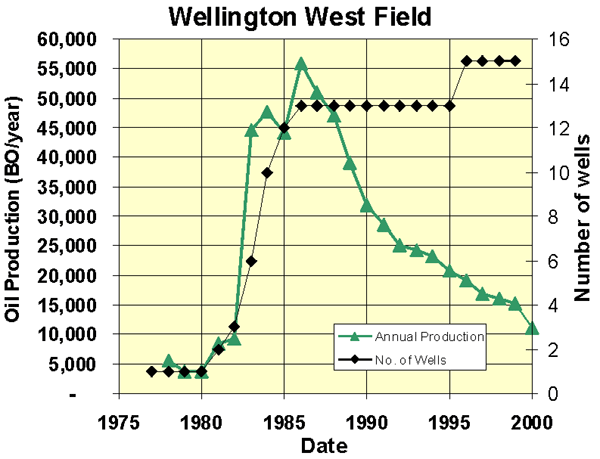 |
|
Kansas Geological Survey Open-file Report 2003-31 |
Production History
The initial production (IP) recorded at Becker No. 1 was 50 bopd. Most of the primary field development occurred between 1983 and 1986. By 1986, the total number of wells in the field was 13 and resulted in the annual oil production to peak at 55,962 bbls (Figure). The combination trap allows wells located low on the structure (subsea depth of 747 m; 2450 feet) and with average permeability to produce oil. Two infill wells, drilled in the later years, were unable to halt the production decline in the field.
The reservoir drive mechanism is attributed to a strong bottom-water drive. Shut-in pressures from drill stem tests (DSTs) recorded in the initial wells indicate the initial reservoir pressure to be close to 2,000 psi. IP rates for most of the wells have ranged between 15 to 30 bopd. However, field-wide differences between the final shut-in pressures (FSIPs) and the final flow pressures (FFPs), from DST records, indicate permeability heterogeneity within the pay zone.
From its discovery to the present, the field has been under primary production without any artificial pressure support. Over the field history of 24 years, reservoir pressure has declined from 2,000 psi to 1,700 psi. The initial recoverable reserves in Wellington West field have been estimated at 6.1 MMstb. Total cumulative recovery, as of 2000, has been 600 Mstb, resulting in a primary recovery efficiency of about 10%.
The American Energies Corporation (AEC) currently operates the Wellington West field. With primary production having reached economic limits, AEC must design and implement an effective secondary recovery strategy to continue operating the field. Recoveries from infill vertical wells have been marginal due to low reservoir pressure and reservoir heterogeneity.
Low primary recovery factors have resulted in significant volumes of residual reserves, estimated at 5.5 MMstb, in the Wellington West field. To implement a development plan capable of recovering some of these reserves this study was conducted.

|
|
Last updated July 2003
http://www.kgs.ku.edu/PRS/publication/2003/ofr2003-31/P1-05a.html
